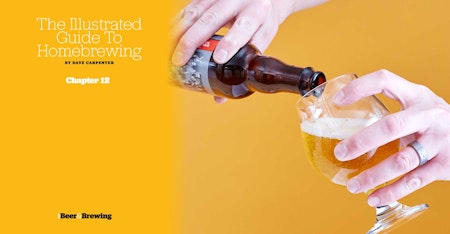Did you hear something down in the basement? Nobody else is home, and the dog is upstairs. Grumbling about mice, you go down to investigate and find the mess: broken bottles and beer everywhere. You have…glass grenades!
There are a few explanations: too much priming sugar, bottling too early, aggressive infections. But the more important question is what should you do now? It all comes down to figuring out whether you can save the beer or just surrender and clear out the hazard.
A Note of Warning
Bottle bombs are very dangerous. If any bottles have exploded, every bottle in that batch should be treated with care and respect. There’s no way to tell if a given bottle is ready to blow, so whether your intent is to save your beer or dispose of it, you need to wear safety gear and minimize the chance of shrapnel injuring you or anyone else. Put on safety glasses at a minimum, but a face shield is even better. Leather work gloves will protect your hands, and I’d wear a heavy jacket as well. Finally, when you’re working with a bottle, you should either wrap it in a towel or hold it in a canvas bag.
First Steps—How Bad Is It?
If you’ve already had an explosion, you need to assess the situation by cooling down a couple of bottles and checking them out. Follow these steps to maximize safety.
- Put on your safety gear.
- Select 2−3 bottles at random and wrap them up in a towel.
- Seal the remaining bottles in cases where they won’t hurt anyone.
- Chill down the selected bottles in the refrigerator for at least an hour or two. This will relieve some of the pressure and let more of the CO2 dissolve into the solution.
- Take your bottles outside and open them one at a time. They may well gush or make a big mess.
a. If the bottles behave differently from one another or if none of the is over-carbonated, that indicates that you either have a bottle infection or poorly mixed priming sugar. You’ll need to handle each bottle in the batch on its own terms.
b. If they’re all over-carbonated, taste the beer. If it’s awful, then you have an infection problem and probably should dispose of the batch.
c. If the beer is okay, then your handling will depend on how over-carbonated the beers were.
d. If the beers turned into malt volcanoes the moment you opened them, then you should probably get rid of them. You’d lose too much beer trying to bleed off the pressure. Otherwise, you can process each bottle to relieve the pressure, as described below.
Save the Ales: Pressure Drop
If the only problem is that the carbonation is too high, you can try to let off some of the CO2 and then recap the bottles. Once a bottle is resealed, carbon dioxide will come out of solution and fill the headspace. It’s a relatively simple process, but I recommend having a helper on hand. Both of you should wear safety gear.
- Start out by chilling the beer in the freezer for an hour or so. It’s best to carefully put a few bottles at a time into a canvas shopping bag and place the bag in your freezer.
- Prepare for the process: sanitize fresh bottle caps and get a spray bottle of sanitizer.
- Remove the bottles from the freezer and take them outside.
- For each bottle, you’ll spray it down with sanitizer and then wrap it with a hand towel. Then, one person will pop the cap, and the other will immediately recap the bottle with a fresh bottle cap.
- Once you’re done, place the bottles in the refrigerator to forestall any further carbonation.
The cold temperature should keep things under control, but if a bottle gushes too quickly, just let it go and move on to the next one. Also, the process may need to be repeated if the beer continues to be too carbonated.
Some people recommend lightly loosening the cap rather than removing it completely. I find that harder to manage because you need to get the capper in place while beer and foam may be spewing out.
Safe Disposal
If the batch is not worth salvaging, you’ll need to play bottle bomb disposal expert. Chill the bottles in the freezer just like with the depressurization process. Then take the bottles outside and defuse each one by opening it quickly and letting it foam. Don’t forget your safety gear.
Final Thoughts
Forewarned is forearmed. It’s best to catch carbonation problems before they become a crisis. Open your first beer 4−5 days after bottling, and you can get a good sense of whether you have carbonation issues. If you do, you can refrigerate the beers early on to slow things down.
Also, this is another good reason to use swing-top resealable bottles. The gasket and metal bailing are much more likely to fail than the glass, so they’re much safer, and it’s fairly easy to open them slightly to bleed off the pressure.








